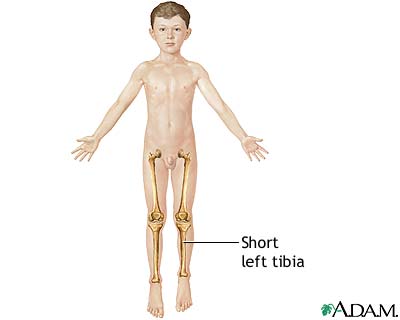Health Library
Leg lengthening - series

Indications
The most common bones treated with lengthening procedures are the bones of the leg, the tibia and the femur.
Surgical treatment may be recommended for severe unequal leg lengths caused by:
- Poliomyelitis and cerebral palsy
- Small, weak (atrophied) muscles or short, tight (spastic) muscles may cause deformities and prevent normal leg growth
- Hip diseases such as Legg-Perthes disease
- Previous injuries or bone fractures that may stimulate excessive bone growth
- Abnormal spinal curvatures (scoliosis)
- Birth defects (congenital deformities) of bones, joints, muscles, tendons, or ligaments

Procedure
While the child is deep asleep and pain-free (using general anesthesia), the surgeons carefully study the blood vessels and blood supply to the bone.
An incision is made in the bone to be lengthened; usually the lower leg bone (tibia) or upper leg bone (femur). Metal pins or screws are inserted into and through the skin and bone above and below the bone incision and the skin incision is stitched closed.
A metal device (such as an Ilizarov device) is attached to the screws in the bone and will be used later to gradually "crank" the cut bone apart, creating a space between the ends of the cut bone, which heals to form new bone. The lengthening device is used very gradually, lengthening the bone in extremely small steps, usually over the course of several months.

Aftercare
The device used to lengthen the leg after placement of the pins usually must stay in place for many months. The leg is gradually lengthened over this time, and the patient is usually able to walk with the device in place. Multiple surgeries are usually required to effect significant lengthening of the limb.
BACK TO TOP
Review Date: 12/12/2022
Reviewed By: C. Benjamin Ma, MD, Professor, Chief, Sports Medicine and Shoulder Service, UCSF Department of Orthopaedic Surgery, San Francisco, CA. Also reviewed by David C. Dugdale, MD, Medical Director, Brenda Conaway, Editorial Director, and the A.D.A.M. Editorial team.
 | A.D.A.M., Inc. is accredited by URAC, for Health Content Provider (www.urac.org). URAC's accreditation program is an independent audit to verify that A.D.A.M. follows rigorous standards of quality and accountability. A.D.A.M. is among the first to achieve this important distinction for online health information and services. Learn more about A.D.A.M.'s editorial policy, editorial process and privacy policy. A.D.A.M. is also a founding member of Hi-Ethics. This site complies with the HONcode standard for trustworthy health information: verify here. |
The information provided herein should not be used during any medical emergency or for the diagnosis or treatment of any medical condition. A licensed medical professional should be consulted for diagnosis and treatment of any and all medical conditions. Links to other sites are provided for information only -- they do not constitute endorsements of those other sites. No warranty of any kind, either expressed or implied, is made as to the accuracy, reliability, timeliness, or correctness of any translations made by a third-party service of the information provided herein into any other language. © 1997- 2024 A.D.A.M., a business unit of Ebix, Inc. Any duplication or distribution of the information contained herein is strictly prohibited.
